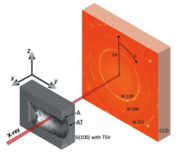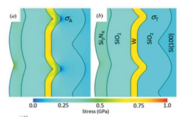Materials Research for Microelectronic Devices
In its division “Materials for Microelectronics” the Materials Center Leoben concentrates on integrated materials-, process- and product engineering of microelectronics components with a strong focus on “More-than-Moore” approaches as used in 3D integrated components and systems.
The challenges mainly result from the mix of materials that are integrated in modern microelectronics devices. Technologies such as "chip-on-chip" (CoC), “wafer level packaging” (WLP), “surface mounted devices” (SMD) in packages, MEMS / NEMS or system-in-package (SiP) are the tags. The ever-increasing density of integration with decreasing component dimensions yield to new damage modes. Considering typical microelectronics components, it becomes clear that the buildup of the multimaterial components is a challenge in terms of thermo-mechanical loading and thermal management in service and production. The structure comprises different materials (metal, silicone, different semiconductors, ceramic, polymer) causing mechanical stresses due to the often large differences in the coefficients of thermal expansion (CTE).
Optimized Coatings for Semiconductors
Thermal and residual stresses on semiconductors have a mayor influence on the yield during processing and the reliability during application. This is especially valid for modern 3D integrated devices where through silicon vias (TSV) are used to connect the front side with the backside. Such structures have a layer wise build up with thin coating made from different material classes. When, for example, a stack of SiOx, Ti, TiN and W is produced, residual stresses develop in all layers.
Spatial resolved characterization of residual stresses structure components can be analysed using nano-beam X-Ray diffraction. With this method MCL together with researchers from university of Leoben and Erich Schmid institute were able to characterize the stress profile in a TSV. Together with the so called Ion Layer Removal method the stress state in plane and out of plane could be determined.
Finite element simulations were not only used to determine effects of sample preparation and recalculate the experiments but also to build up a design tool for construction of stress reduced stacks.
Contact: Stefan Defregger
Calculation of Crack Behaviour in Multimaterial Structures
Understanding the origin and growth behaviour of cracks in material compounds is a key issue for describing the reliability of electronic components. In order to determine the magnitude and direction of the crack driving force in materials, different fracture mechanics concepts are used.
The MCL has recently developed the "Configurational Forces" concept further in order to make it easy useable for cracks in layered multimaterial structures. The configurational forces concept in the theory of elasticity goes back to the work of Eshelby in the 1960s. He used the energy-momentum tensor to describe the driving forces on material defects, such as dislocations, interstitial atoms, phase boundaries or crack tips. In the works of Simha et al. and Kolednik et al. the concept was expanded in collaboration with the MCL in order to describe the driving force in heterogeneous structures where residual stresses and plasticity may occur. As a result, this energy-based approach can be generally applied and without restrictions to determine the driving forces for cracks depending on the layered structure architecture, on the elastic and plastic properties of the materials involved and on the residual stresses.
The material forces concept can be used to increase the damage resistance and the lifetime of the components.
Contact: Werner Ecker
Inverse Determination of Interfacial Strengths
Interfaces often represent weak points. Therefore, it is essential to know their strengths and interfacial energy. At the MCL, interfacial strengths are determined by means of a 4-point bending test and sub-sequent inverse simulations. In these inverse simulations the interfacial strength is determined by optimum reproduction of the experimentally determined macroscopic mechanical response using cohesive elements in the FE simulation.
Contact: Werner Ecker



















![[Translate to Englisch:] Wolframoxid-Nanowires](/fileadmin/_processed_/5/6/csm_Material_Wolframoxid_nanowires_671530331d.jpg)



